Apple iPad 2 Preview
by Anand Lal Shimpi, Brian Klug & Vivek Gowri on March 12, 2011 6:01 AM ESTWiFi + AT&T 3G
The iPad 2 uses what boils down to same exact same 802.11a/b/g/n WiFi + Bluetooth 2.1 EDR solution as its predecessor, the BCM4329. The iPad 2 maintains full 5 GHz (802.11a/n) support, just like the previous iPad, and also negotiates a transmit rate of 65 megabits/s just like nearly all single stream 802.11n mobile devices we've seen thus far. Close to the AP and within good coverage radius, the experience is exactly the same as its predecessor. Best case throughput is virtually identical between the two generations.
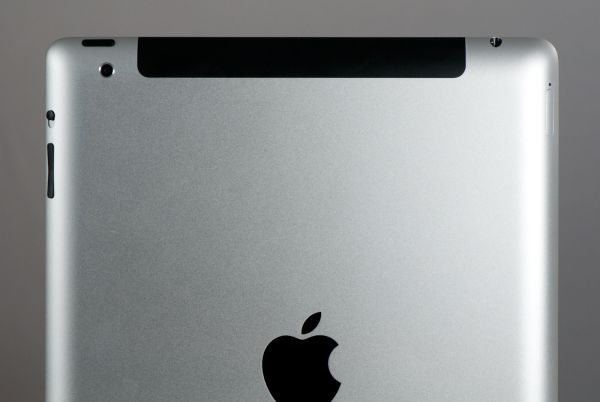
The black plastic strip at the top still is an RF window for cellular connectivity. The strip is black even if your iPad is white, which is a bit puzzling.
That said, thus far we've noticed that wireless range on the iPad 2 is measurably less than the iPad 1. It's not a terribly huge difference, but definitely noticeable as you drop one or two bars of WiFi signal strength. Throughput goes way down compared to the previous generation. We're still testing everything, but it's just not quite as good. No doubt the iPad 2 has a completely different RF design than the original iPad which accounts for this difference.
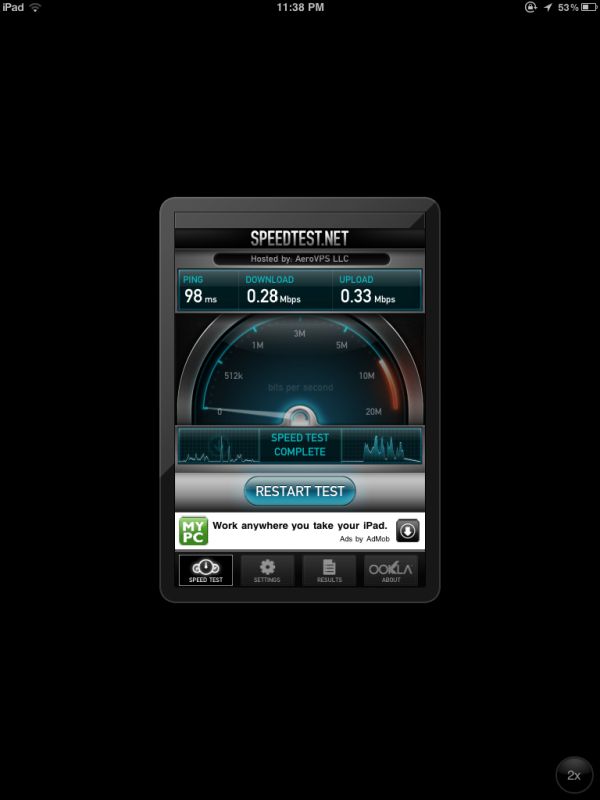
Left: iPad 1 across the street, Right: iPad 2 same location
We've got both an AT&T, Verizon, and WiFi model between the three of us (Anand, Vivek, and myself) and will do the usual due diligence testing cellular connectivity.
Following the rather controversial and inexplicable crippling of HSUPA on the Motorola Atrix and Inspire 4G, the first thing I did with the iPad 2 is run a speedtest. HSUPA is definitely enabled on this device and working just fine. Throughput is where it should be in the best and worst signal cases so far, topping out at around 6 Mbps down, 1.5 Mbps up at my house within line of sight to an AT&T Node B. Apparently AT&T is inexplicably only concerned with Android devices crippling the network with upstream traffic.
AT&T iPad 2 Cellular Data Throughput
Anand did some initial testing on the Verizon iPad 2 and averaged 1.54 Mbps down, 0.72 Mbps up in testing with good signal strength, which seems about average. Max speeds we've seen on Verizon so far are 1.64 Mbps down and 0.82 Mbps up.
| iPad 2 - Network Support | |||||
| Verizon Version - CDMA2000-1xEV-DO | 800 / 1900 MHz | ||||
| AT&T Version - Quad-Band UMTS + HSDPA/HSUPA | 850 / 900 / 1900 / 2100 MHz | ||||
| AT&T Version - Quad-Band GSM/EDGE | 850 / 900 / 1800 / 1900 MHz | ||||
| Baseband Hardware | Unknown - Possibly MDM6x00 | ||||
Nobody has disassembled an iPad 2 with 3G connectivity from either Verizon or AT&T, but it seems likely that the two would both leverage a Qualcomm MDM6x00 baseband (where x is 6 for CDMA2000/EV-DO + UMTS/GSM support, 2 for only UMTS/GSM) considering its use in the Verizon iPhone 4.
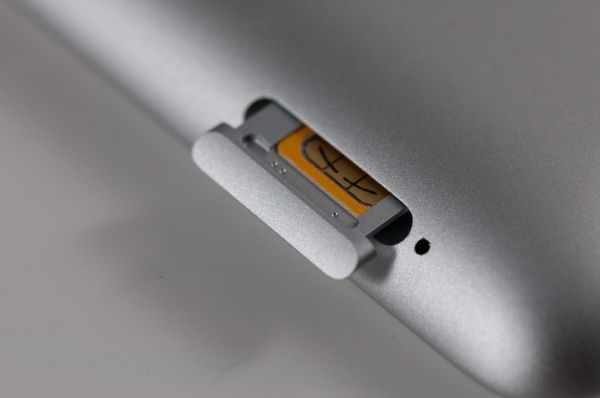 MicroSIM peeking out of the side on the AT&T version. Also yes, it does come with a SIM ejector tool.
MicroSIM peeking out of the side on the AT&T version. Also yes, it does come with a SIM ejector tool.
Interestingly enough the AT&T model with FCC ID BCG1396 has UMTS/HSDPA/HSUPA support for quad-band UMTS and GSM. The Verizon FCC ID BCG1397 has reports for just cellular and PCS - 850 and 1900 again but CDMA nomenclature.


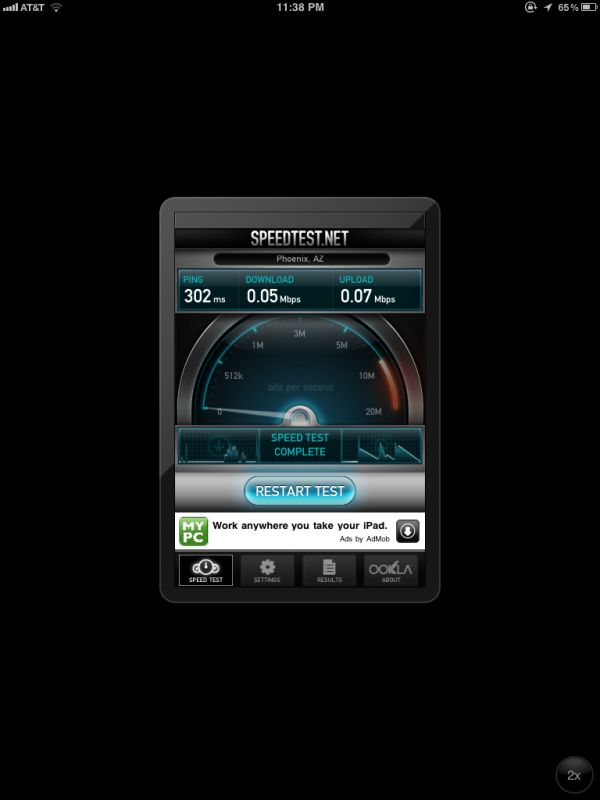
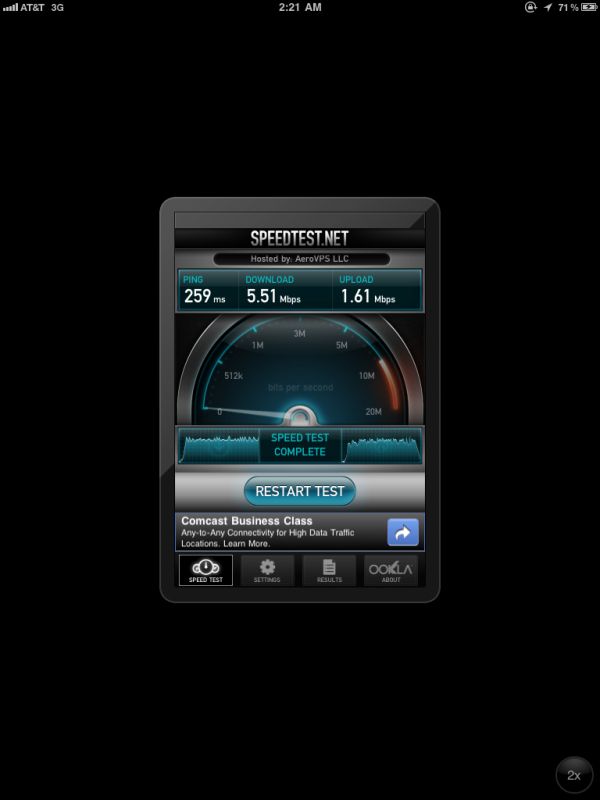








82 Comments
View All Comments
Brian Klug - Monday, March 14, 2011 - link
That's weird that the apple rep would say those things. The current MacBook is entirely hard plastic, and lacks the matte soft-touch material that used to stain. The current iPad is actually indeed covered in glass the same as the black model, so it will absolutely not stain.-Brian
podpi - Sunday, March 13, 2011 - link
Hey AnandLet me preface this by saying I'm a huge Anandtech fan, and really trust and appreciate your word and the deep, thorough reviews you do. That's what sets you apart from the other tabloidy, first out, sort of content. They do anything to have content out first. I believe some write the reviews before they test the equipment.
Now, whenever any big product comes out, I may glance at the Engadget/Wired reviews, but I keep checking Anandtech everyday, waiting eagerly in anticipation. The other sites try and up the number of views, so they launch bit by bit and try and draw it out, but also try and be out first with a brief headline-like review. Quality suffers. So I keep checking AT, and waiting for a thorough, unbiased, great reading review. And when it comes out, sometimes up to a week later than the rest. By then the hype had died, down, and it has a chance to come in clean, and see what someone who put the effort in actually thought of the product. The fact that your reviews tend to be a little later show to me how much effort you put in, and how much you care about quality. And this is what I appreciate.
Now, with the iPad 2 review, it seems to be coming in drips and drabs, to try and what appears to be to keep up with the competition? I think it's natural to get into a race with those sites. But how can you win a race against tech-tabloids? If you blend in with the crowd, then there is little differentiation. I don't think you can have best of both. In my opinion, taking your time and giving a full long in-depth review, like a short story, provides a unique, quality characteristic to your reviews, site and brand.
Thanks for the great work.
Terence
Brian Klug - Monday, March 14, 2011 - link
Terence,I actually agree with you that we really excel at the longer reviews, and it's good to hear that even though we're sometimes much later than everyone else, that it's still useful. I know I enjoy spending a lot of time being exacting about things and sometimes going behind schedule just to uncover absolutely everything.
We were able to get a preview out on day one this time around just because we have about four people with iPads this time around, where with most things we'll only have one (or in extreme cases, two) units. Each of us working in parallel really sped things up and we thought we'd just share some quick impressions.
The big review is still coming (today actually - 3/14) and will be the usual length/depth for certain ;)
-Brian
Belard - Sunday, March 13, 2011 - link
As an owner of a Galaxy S series, with poor support from Samsung/at&t and my experience of using an Android device phone for almost 6 months.Using the iPad2 was a breeze, its was fast and fun to use. Yeah, the missing USB & SD slots still sucks... but that won't effect sales much.
We then went across the isle to the Samsung Galaxy Tab which costs the exact same $500. It was easily heavier, thicker... the GUI looks and functions mostly like my own phone so I had no problems "using it".
So after that experience, we both agreed... why spend $500 on an Android, when we could get a much snappier, larger screen and much easier to use device. BestBuy was sold out.
If the Galaxy Tab was $300~350 - it would be a more fair deal.
podpi - Monday, March 14, 2011 - link
Thanks Brian - looking forward to it :)ssvb - Monday, March 14, 2011 - link
VFPv2 unit in ARM11 is actually pipelined: http://infocenter.arm.com/help/topic/com.arm.doc.d...And yes, naturally it is much faster than Cortex-A8 on floating point code.
NCM - Monday, March 14, 2011 - link
AT: "Laying in bed and reading is probably where the difference becomes most apparent."You should never read in bed while laying—your partner will be offended.
It's perfectly all right while lying in bed, however.
eanazag - Monday, March 14, 2011 - link
I really appreciated the mouse over images changing comparison. It really gave a clear picture of the difference in the images.retnuh - Wednesday, March 16, 2011 - link
So.... being the 16th should we assume its getting the super mega awesome thorough testing treatment?UNLK A6 - Thursday, March 17, 2011 - link
I'd like some clarification about LINPACK and Geekbench. Are these benchmarks created by compiling some portable code for each platform as a measure of floating point performance? Or, is this supposed to be some measure of how fast one can do linear algebra or DSP on the platform? On Mac OS and iOS, one wouldn't compile say LINPACK for this but use the hand-tuned LAPACK/BLAS and DSP routines built into Apple's Accelerate Framework. The difference between the two can be huge. Which do these benchmarks purport to supply--generic floating point performance or available linear algebra and DSP performance?